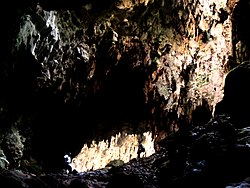| Callao Cave | |
|---|---|
 Callao Cave's fifth chamber | |
| Location | Peñablanca, Cagayan Philippines |
| Coordinates | 17°42′11.74″N 121°49′25.5″E / 17.7032611°N 121.823750°E |
| Geology | Limestone formation[1] |
| Entrances | One |
| Difficulty | Easy |
| Hazards | Wet cave floor |
| Access | Public |
| Show cave opened | Callao Cave's seven chambers |
| Lighting | Natural roof crevice |
| Features | Church built inside the first chamber |
Callao Cave (IPA: [ˈkalaʊ]) is one of 300 limestone caves located in the Barangays of Magdalo and Quibal in the municipality of Peñablanca, about 24 km (15 mi) northeast of Tuguegarao City, the capital of Cagayan province within the Peñablanca Protected Landscape and Seascape in the western foothills of the Northern Sierra Madre Mountains on Luzon island in the Philippines. The town Peñablanca's (Spanish: white rocks) name refers to the predominance of white limestone rock formations in the area. First excavated in 1980 by Maharlika Cuevas, the seven-chamber show cave is the best known natural tourist attraction of the Cagayan province and in February 2020 has officially been recognized as an important cultural property of the Philippines.[2][3][4][5]
These Fossils of archaic humans, that lived during the Late Pleistocene were first discovered in the cave and documented in 2007 by a team led by Armand Salvador Mijares from the University of the Philippines and eventually confirmed in 2019 to belong to a previously unknown and now extinct human sub-species - Callao Man or Homo luzonensis.[6][7]
- ^ Guillermo, Artemio R. (2012). "Historical Dictionary of the Philippines, 3rd edition", pg. 125. Scarecrow Press, Inc., Maryland.
- ^ Cite error: The named reference
cagayanwas invoked but never defined (see the help page). - ^ "Protected Areas of Region 2 Map" Archived December 31, 2013, at the Wayback Machine. Protected Areas and Wildlife Bureau. Retrieved on October 3, 2013.
- ^ "Callao Cave in Cagayan declared an 'important cultural property'". Southeast Asian Archaeology. February 5, 2020. Retrieved July 1, 2020.
- ^ European Association of Southeast Asian Archaeologists. International Conference; Ian Glover; European Association of Southeast Asian Archaeologists (2006). Uncovering Southeast Asia's Past: Selected Papers from the 10th International Conference of the European Association of Southeast Asian Archaeologists : the British Museum, London, 14th-17th September 2004. NUS Press. pp. 361–. ISBN 978-9971-69-351-0.
- ^ Greshko, Michael; Wei-Haas, Maya (April 10, 2019). "New species of ancient human discovered in the Philippines". National Geographic. Archived from the original on April 10, 2019. Retrieved July 1, 2020.
- ^ Jhesset O. Enano (February 5, 2020). "Callao Cave in Cagayan declared an 'important cultural property'". INQUIRER. Retrieved July 1, 2020.
